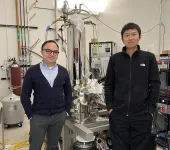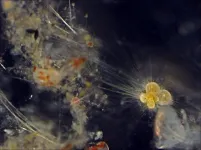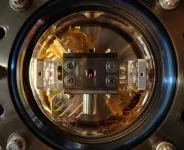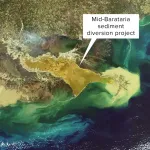(Press-News.org) After soliciting feedback from its members, the American Society for Biochemistry and Molecular Biology sent nine recommendations to the National Institutes of Health last week related to proposed changes to the research grant application peer-review process.
The society’s March 1 letter suggested:
Validating the proposed framework with a pilot study
Revamping the study section grant triage process
Conducting outreach before and during implementation
Using alternative criteria for certain types of projects
Moving forward with simplifying scored criteria and administrative document review
The NIH Office of Extramural Research published a request for information on Dec. 7 seeking public input on a proposed revised framework for evaluating and scoring of peer-reviewed research project grant applications from the NIH Center for Scientific Review.
The proposed framework reduces the number of categories reviewers must evaluate and asks that reviewers focus on two major questions: “Should it be done?” and “Can it be done well?” In addition, the framework proposes removing individual scoring for the investigator and environment. Instead, reviewers would qualitatively evaluate and rate an applicant’s expertise and resources with the goal of reducing bias in peer review. Finally, study section volunteers would review less material from the “Additional Review Considerations” section of the application.
The goal of the revised framework is two-fold. First, the NIH seeks to reduce the emphasis on investigator reputation during grant review. Second, the NIH seeks to reduce the administrative burden on study section members.
The ASBMB was compelled to respond because the society is composed of predominately NIH-funded investigators, many of whom serve on study sections.
“Since the majority of our members will be directly affected by any changes to NIH grant review processes, we felt it was our responsibility to make sure their voices are heard as well as support their continued success in receiving federal funding,” Sarina Neote, director of public affairs at the ASBMB, said. “In addition, since part of our mission is advocating for underrepresented groups, we want to ensure that these proposed changes are making the review process more equitable for researchers at all levels.”
Although the ASBMB expressed support for NIH’s efforts to simplify and make peer review less biased, Neote said, the society wants to ensure the proposed changes also accomplish NIH’s goals.
In its comment letter to CSR, the society wrote: “To validate that the proposed framework reduces reputational bias and ensure that the proposed changes are data-driven, the ASBMB asks CSR to conduct a thorough pilot study of the proposed framework across all research project grants.”
During study section, only the preliminarily top scoring grants are discussed. This process leaves all borderline and low-scoring grants behind, known as triage. Every study section member has the opportunity to bring forward a triaged proposal that may have received a borderline score due to receiving two outstanding and one low, outlier score. However, this rarely occurs. Therefore, the ASBMB recommended revamping the triage process to build in time for study section discussion of borderline-scoring applications.
“This goal could be accomplished in two ways: First, task the scientific review officer with initiating discussion of borderline-scoring proposals and/or second, automatically include a set time for discussion of these proposals,” the ASBMB wrote. “The ASBMB urges CSR to ensure that quality scientific research projects are not left behind during the triage process.”
Because the current framework has been in place for decades, the ASBMB asserted that substantial outreach and education will be needed to ensure a seamless transition to the new framework. The society called upon NIH to make educational resources such as toolkits broadly available, not only to high-research-activity institutions but to emerging and minority-serving institutions as well.
The society also expressed concern about using the proposed framework to evaluate all research grants, in particular R15 awards. According to the NIH, R15 awards are research enhancements that are designed to support “small-scale research projects at educational institutions that provide baccalaureate or advanced degrees for a significant number of the nation’s research scientists but that have not been major recipients of NIH support.”
The society wrote: “Although R15s are similar to other research grants that fund meritorious research projects, the mechanisms of scope and feasibility can vary depending on the capacity of the institution. … (T)he smaller scope of work that is feasible at primarily undergraduate institutions may be disadvantaged under the new framework in comparison with larger labs that host undergraduate research.”
END
ASBMB offers feedback on NIH’s proposed grant review framework
The society expresses support for measure to reduce bias, calls for pilot study and triage reform
2023-03-06
ELSE PRESS RELEASES FROM THIS DATE:
The marathon runners of the immune system
2023-03-06
When it comes to chronic infections and cancer, a particular type of immune cell plays a central role in our defenses. Researchers at the University of Basel have uncovered the key to the tenacity of these immune cells in coping with the marathon that is fighting a chronic infection. Their results lay the foundations for more effective therapies and vaccination strategies.
Infected and abnormal cells have to go. And as quickly as possible, before any more damage is done. This is the task of what are known as cytotoxic T cells. ...
A wholly sustainable plastics economy is feasible
2023-03-06
Plastic is everywhere. Our society cannot do without it: plastics have numerous advantages, are extremely versatile, and are also cost effective. Today, plastics are mainly produced from crude oil. When the products reach the end of their life, they often end up in a waste incineration plant. The energy-intensive production of plastics and their incineration release large amounts of CO2 into the atmosphere, making plastic products a major contributor to climate change.
One way out would be to rely on sustainable production methods, such as the circular economy, in which as much plastic as possible is recycled. Then the main raw material for ...
Graphene quantum dots show promise as novel magnetic field sensors
2023-03-06
Trapped electrons traveling in circular loops at extreme speeds inside graphene quantum dots are highly sensitive to external magnetic fields and could be used as novel magnetic field sensors with unique capabilities, according to a new study.
Electrons in graphene (an atomically thin form of carbon) behave as if they were massless, like photons, which are massless particles of light. Although graphene electrons do not move at the speed of light, they exhibit the same energy-momentum relationship as photons and can be described as “ultra-relativistic.” ...
Parental nonadherence to recommendations for COVID-19 prevention among children
2023-03-06
About The Study: In this survey study of U.S. parents, one-quarter engaged in misrepresentation or nonadherence regarding public health measures for their children. The most common reason was to preserve parental autonomy. Additional reasons included wanting to resume a normal life for their child and the inability to miss work or other responsibilities, among other reasons.
Authors: Andrea Gurmankin Levy, Ph.D., M.B.E., of Middlesex Community College in Middletown, Connecticut, is the corresponding author.
To access the embargoed study: Visit our ...
Mineral particles and their role in oxygenating the Earth’s atmosphere
2023-03-06
Mineral particles played a key role in raising oxygen levels in the Earth’s atmosphere billions of years ago, with major implications for the way intelligent life later evolved, according to new research.
Up to now, scientists have argued that oxygen levels rose as the result of photosynthesis by algae and plants in the sea, where oxygen was produced as a by-product and released into the atmosphere.
But a research ...
Two-dimensional quantum freeze
2023-03-06
Glass nanoparticles trapped by lasers in extreme vacuum are considered a promising platform for exploring the limits of the quantum world. Since the advent of quantum theory, the question at which sizes an object starts being described by the laws of quantum physics rather than the rules of classical physics has remained unanswered.
A team formed by Lukas Novotny (Zurich), Markus Aspelmeyer (Vienna), Oriol Romero-Isart (Innsbruck), and Romain Quidant (Zurich) is attempting to answer precisely this question within the ERC-Synergy project Q-Xtreme. A crucial step ...
Scientists twist chemical bonds beyond their limits
2023-03-06
A group of scientists from Durham University and University of York have twisted molecules to their breaking point in order to challenge the understanding of chemical bonds.
The researchers explored how far the chemical bonding in an aromatic ring can be twisted before its aromatic bonding breaks.
They achieved this by making overcrowded aromatic rings. Rather than benzene, they used tropylium, which shares electrons around a ring of seven carbon atoms.
Each of these carbon atoms can be functionalised and having seven attachment points in the ring, rather than the six carbon atoms of benzene, allowed ...
Siblings should be screened in cases of suspected child physical abuse
2023-03-06
Siblings of a child suspected of experiencing physical abuse should also be screened for abusive injuries, according to a new international consensus statement led by researchers at UCL (University College London) and Great Ormond Street Hospital for Children (GOSH).
The team of 27 researchers, from six different continents, are calling for a policy change to stop inconspicuous injuries being missed in contact children (i.e. siblings, cohabiting children, or children who are under the same care), and to help prevent further ...
Rewarding accuracy instead of partisan pandering reduces Republican-Democrat divide over the truth – study
2023-03-06
Offering a tiny cash reward for accuracy, or even briefly appealing to personal integrity, can increase people’s ability to tell the difference between misinformation and the truth, according to a new study.
The findings suggest that fake news thrives on social media not only because people are tricked into believing it, but also due to a motivational imbalance: users have more incentive to get clicks and likes than to spread accurate content.
Social psychologists from the University of Cambridge and New York University argue that their study, published in the journal ...
New study compares human contributions to Mississippi river delta land loss, hints at solutions
2023-03-06
Research from scientists at Louisiana State University and Indiana University reveals new information about the role humans have played in large-scale land loss in the Mississippi River Delta—crucial information in determining solutions to the crisis.
The study published today in Nature Sustainability compares the impacts of different human actions on land loss and explains historical trends. Until now, scientists have been unsure about which human-related factors are the most consequential, and why the most rapid land loss in the Mississippi River Delta occurred between the 1960s and 1990s and ...
LAST 30 PRESS RELEASES:
Making lighter work of calculating fluid and heat flow
Normalizing blood sugar can halve heart attack risk
Lowering blood sugar cuts heart attack risk in people with prediabetes
Study links genetic variants to risk of blinding eye disease in premature infants
Non-opioid ‘pain sponge’ therapy halts cartilage degeneration and relieves chronic pain
AI can pick up cultural values by mimicking how kids learn
China’s ecological redlines offer fast track to 30 x 30 global conservation goal
Invisible indoor threats: emerging household contaminants and their growing risks to human health
Adding antibody treatment to chemo boosts outcomes for children with rare cancer
Germline pathogenic variants among women without a history of breast cancer
Tanning beds triple melanoma risk, potentially causing broad DNA damage
Unique bond identified as key to viral infection speed
Indoor tanning makes youthful skin much older on a genetic level
Mouse model sheds new light on the causes and potential solutions to human GI problems linked to muscular dystrophy
The Journal of Nuclear Medicine ahead-of-print tip sheet: December 12, 2025
Smarter tools for peering into the microscopic world
Applications open for funding to conduct research in the Kinsey Institute archives
Global measure underestimates the severity of food insecurity
Child survivors of critical illness are missing out on timely follow up care
Risk-based vs annual breast cancer screening / the WISDOM randomized clinical trial
University of Toronto launches Electric Vehicle Innovation Ontario to accelerate advanced EV technologies and build Canada’s innovation advantage
Early relapse predicts poor outcomes in aggressive blood cancer
American College of Lifestyle Medicine applauds two CMS models aligned with lifestyle medicine practice and reimbursement
Clinical trial finds cannabis use not a barrier to quitting nicotine vaping
Supplemental nutrition assistance program policies and food insecurity
Switching immune cells to “night mode” could limit damage after a heart attack, study suggests
URI-based Global RIghts Project report spotlights continued troubling trends in worldwide inhumane treatment
Neutrophils are less aggressive at night, explaining why nighttime heart attacks cause less damage than daytime events
Menopausal hormone therapy may not pose breast cancer risk for women with BRCA mutations
Mobile health tool may improve quality of life for adolescent and young adult breast cancer survivors
[Press-News.org] ASBMB offers feedback on NIH’s proposed grant review frameworkThe society expresses support for measure to reduce bias, calls for pilot study and triage reform



